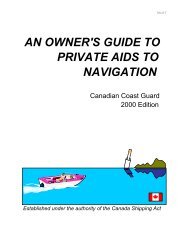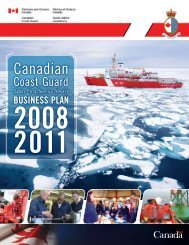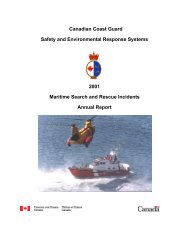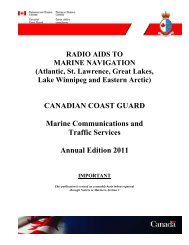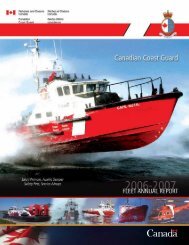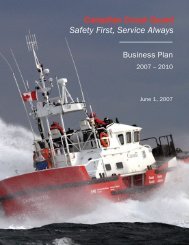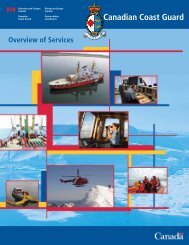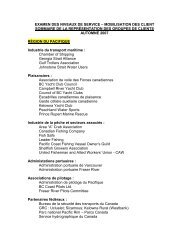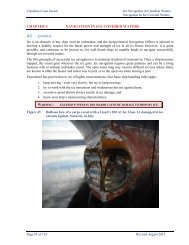PART 4 - Canadian Coast Guard
PART 4 - Canadian Coast Guard
PART 4 - Canadian Coast Guard
Create successful ePaper yourself
Turn your PDF publications into a flip-book with our unique Google optimized e-Paper software.
3 HF<br />
As for MF, but the alert must be cancelled on all the frequency bands on which it was transmitted. Hence, in stage<br />
2.2 the transmitter should be tuned consecutively to the radiotelephony distress frequencies in the 4, 6, 8, 12 and<br />
16 MHz bands, as necessary.<br />
4 Inmarsat-C<br />
Notify the appropriate JRCC to cancel the alert by sending a distress priority message via the same CES through<br />
which the false distress alert was sent.<br />
NAME, CALL SIGN, IDENTITY NUMBER,<br />
POSITION,<br />
Cancel my Inmarsat-C distress<br />
alert of DATE, TIME UTC<br />
= Master +<br />
5 EPIRBs<br />
If for any reason an EPIRB is activated accidentally, the ship should contact the nearest coast station or an<br />
appropriate coast earth station or JRCC and cancel the distress alert.<br />
6 General<br />
6.1 Notwithstanding the above, ships may use any means available to them to inform the appropriate<br />
authorities that a false distress alert has been transmitted and should be cancelled.<br />
6.2 No action will normally be taken against any ship or mariner for reporting and cancelling a false distress<br />
alert. However, in view of the serious consequences of false alerts, and the strict ban on their<br />
transmission, Governments may prosecute in cases of repeated violations.<br />
1 Introduction<br />
Procedure for Responding to DSC Distress Alerts by Ships<br />
(COMSAR/Circ.25)<br />
The Sub-Committee on Radiocommunications and Search and Rescue (COMSAR) decided that Digital Selective Calling<br />
(DSC) relays of distress alerts on all shipborne DSC equipment should be reduced and prepared a procedure for responding<br />
to VHF/MF and HF distress alerts, given in flow diagrams 1 and 2 which follow, recommending that it be displayed on the<br />
ship's bridge as A4 size posters. It also prepared the following guidance.<br />
2 Distress relays<br />
2.1 Radio personnel serving on ships should be made aware of the consequences of transmitting a distress<br />
relay call and of routing a DSC distress relay alert to other than coast stations (CS).<br />
2.2 The number of unintended activations of DSC distress alerts and DSC distress relay alerts creates extra<br />
work load and confusion to (M) JRCCs and also causing delay in the response-time. The original distress<br />
alert from a ship in distress should not be disrupted by other ships, by transmitting a DSC distress relay<br />
alert.<br />
4-22




